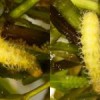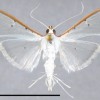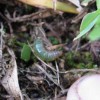 Parapoynx diminutalis Snellen is an adventive Asian moth with an aquatic larval stage. The moth is found associated with a variety of water bodies including river backwaters, lakes, and ponds. The aquatic larvae commonly attack hydrilla and other aquatic plants. The moth was identified in 1971 in India and Pakistan during scouting trips to attempt to determine potential biological control agents for hydrilla. Despite having potential for hydrilla destruction, the moth was declared to be a generalist feeder and unsuitable for release into U.S. water bodies for hydrilla control. But the moth was later found in Florida in 1976 by United States Department of Agriculture technicians who were testing herbicides for hydrilla control. The larvae found on hydrilla were observed to be eating the invasive weed. The pathway, method, or time of the moth’s arrival remains unknown. This 5-page fact sheet was written by Julie Baniszewski, Emma N.I. Weeks, and James P. Cuda, and published by the UF Department of Entomology and Nematology, January 2014.
Parapoynx diminutalis Snellen is an adventive Asian moth with an aquatic larval stage. The moth is found associated with a variety of water bodies including river backwaters, lakes, and ponds. The aquatic larvae commonly attack hydrilla and other aquatic plants. The moth was identified in 1971 in India and Pakistan during scouting trips to attempt to determine potential biological control agents for hydrilla. Despite having potential for hydrilla destruction, the moth was declared to be a generalist feeder and unsuitable for release into U.S. water bodies for hydrilla control. But the moth was later found in Florida in 1976 by United States Department of Agriculture technicians who were testing herbicides for hydrilla control. The larvae found on hydrilla were observed to be eating the invasive weed. The pathway, method, or time of the moth’s arrival remains unknown. This 5-page fact sheet was written by Julie Baniszewski, Emma N.I. Weeks, and James P. Cuda, and published by the UF Department of Entomology and Nematology, January 2014.
http://edis.ifas.ufl.edu/in1024
Tag: Family: Crambidae
Olive shootworm, Palpita persimilis Munroe (Insecta: Lepidoptera: Crambidae)
 Palpita persimilis Munroe (Lepidoptera: Crambidae) is a defoliator of olives and privet in South America. Examination of specimens submitted to UF-IFAS and FDACS-DPI prompted the discovery that the species has been established in Florida for many years, having been confused with two similar native species. The confusion parallels historical misidentifications in Peru. To date, all vouchered specimens in Florida with host information were found feeding on leaves of Ligustrum japonicum Thunb. (Japanese privet). This 6-page fact sheet was written by James E. Hayden and Lyle J. Buss, and published by the UF Department of Entomology and Nematology, May 2013.
Palpita persimilis Munroe (Lepidoptera: Crambidae) is a defoliator of olives and privet in South America. Examination of specimens submitted to UF-IFAS and FDACS-DPI prompted the discovery that the species has been established in Florida for many years, having been confused with two similar native species. The confusion parallels historical misidentifications in Peru. To date, all vouchered specimens in Florida with host information were found feeding on leaves of Ligustrum japonicum Thunb. (Japanese privet). This 6-page fact sheet was written by James E. Hayden and Lyle J. Buss, and published by the UF Department of Entomology and Nematology, May 2013.
http://edis.ifas.ufl.edu/in995
Tropical sod webworm Herpetogramma phaeopteralis Guenee (Insecta: Lepidoptera: Crambidae) (EENY541/IN968)
 Tropical sod webworm larvae are destructive pests of warm season turfgrasses in the southeastern U.S., especially on newly established sod, lawns, athletic fields, and golf courses. Larval feeding damage reduces turfgrass aesthetics, vigor, photosynthesis and density. The first sign of damage is often caused by differences in grass height in areas where larvae are feeding. This 5-page fact sheet was written by Nastaran Tofangsazie, Steven P. Arthurs, and Ronald Cherry, and published by the UF Department of Entomology and Nematology, November 2012.
Tropical sod webworm larvae are destructive pests of warm season turfgrasses in the southeastern U.S., especially on newly established sod, lawns, athletic fields, and golf courses. Larval feeding damage reduces turfgrass aesthetics, vigor, photosynthesis and density. The first sign of damage is often caused by differences in grass height in areas where larvae are feeding. This 5-page fact sheet was written by Nastaran Tofangsazie, Steven P. Arthurs, and Ronald Cherry, and published by the UF Department of Entomology and Nematology, November 2012.
http://edis.ifas.ufl.edu/in968
European Pepper Moth or Southern European Marsh Pyralid Duponchelia fovealis (Zeller) (Insecta: Lepidoptera: Crambidae) (EENY508/IN910)
 Researchers are monitoring this notable greenhouse pest in northern Europe and Canada for the cut flower, vegetable and aquatic plant industries. Its native range is southern Europe, the eastern Mediterranean region, the Canary Islands, Syria and Algeria, but it has expanded its range to include other parts of Africa and the Middle East, northwest India, Europe, Canada and the United States. Recent survey detected adults in pheremone traps in 20 of the 26 Florida counties surveyed. This 11-page fact sheet was written by Stephanie D. Stocks and Amanda Hodges, and published by the UF Department of Entomology and Nematology, December 2011.
Researchers are monitoring this notable greenhouse pest in northern Europe and Canada for the cut flower, vegetable and aquatic plant industries. Its native range is southern Europe, the eastern Mediterranean region, the Canary Islands, Syria and Algeria, but it has expanded its range to include other parts of Africa and the Middle East, northwest India, Europe, Canada and the United States. Recent survey detected adults in pheremone traps in 20 of the 26 Florida counties surveyed. This 11-page fact sheet was written by Stephanie D. Stocks and Amanda Hodges, and published by the UF Department of Entomology and Nematology, December 2011.
http://edis.ifas.ufl.edu/in910
EENY424/IN803 Waterlily Leafcutter, Synclita obliteralis (Walker) (Insecta: Lepidoptera: Crambidae: Acentropinae)
EENY-424, a 4-page illustrated fact sheet by Dale H. Habeck and James P. Cuda, is part of the Featured Creatures collection. It describes this common moth that has been observed to inflict severe damage on the invasive aquatic plant Hygrophila polysperma — its distribution, description, life cycle and biology, hosts, economic importance, and related species. Includes selected references. Published by the UF Department of Entomology and Nematology, February 2009.
http://edis.ifas.ufl.edu/IN803